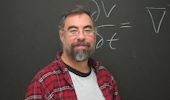The Physics & Astronomy Colloquium Series presents Flavio Fenton of Georgia Institute of Technology on “From Chaos to Cures: Controlling the Complex Spatiotemporal Dynamics of Cardiac Arrhythmias using a Theoretical, Numerical and Experimental Integrative Approach” on Friday, Feb. 5, at 4:10 p.m. in Walter 245.
Abstract: The heart is an electro-mechanical system in which, under normal conditions, electrical waves propagate in a coordinated manner to initiate an efficient contraction. In pathologic states, single and multiple rapidly rotating spiral and scroll waves of electrical activity can appear and generate complex spatiotemporal patterns of activation that inhibit contraction and can be lethal if untreated. Despite much study, many questions remain regarding the mechanisms that initiate, perpetuate, and terminate reentrant waves in cardiac tissue.
In this talk, we will discuss how we use a combined experimental, numerical and theoretical approach to better understand the dynamics of cardiac arrhythmias. We will show how large scale GPU simulations and state-of-the-art optical mapping with voltage-sensitive fluorescent dyes can be used to image the electrical waves present in cardiac tissue, leading to new insights about their underlying dynamics. We will present experimental data from hearts ranging from zebra fish to rabbits, cats, dogs, pigs and horses and discuss how period-doubling bifurcations that arise at fast heart rates can lead to complex spatiotemporal patterns and multistability between single and multiple spiral waves in two and three dimensions. Then we will show how control algorithms tested in computer simulations can be used in experiments to continuously guide the system toward an unstable fixed point in order to prevent and terminate complex electrical patterns characteristic of arrhythmias. We will proceed to establish a relationship between the response of cardiac tissue to an electric field and the spatial distribution of heterogeneities due to the coronary vascular structure, and discuss how in response to a pulsed electric field E, these heterogeneities serve as nucleation sites for the generation of intramural electrical waves with a source density ρ(E) and a characteristic time constant τ for tissue excitation that obeys a power law. We will finish by showing how these results can be applied in vitro and in vivo to develop a novel low energy control algorithm that could be used clinically that requires only 10% of the energy currently used by standard methods to defibrillate the heart.
















Comments